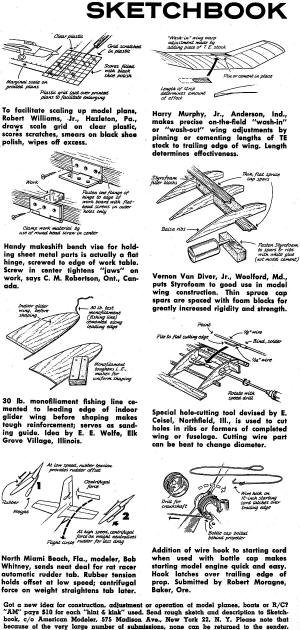|
This "Sketchbook" was scanned
from the March 1961 American Modeler magazine, page 60. Most building tips are timeless.
Even in this era of ready-to-fly (RTF), almost-ready-to-fly (ARF), bind-and-fly
(BAF), etc., there are still many modelers who build their own aircraft. Nearly
all top tier competition fliers build their own models, as do aficionados of
vintage (aka old-timer) models. Some guys just would rather build than buy a
pre-build airplane, whether from a kit or from plans. There is an
interesting suggestion for making fine adjustments on free flight models for wash−in and wash−out
while at the flying field, which could be useful when trimming for a contest.
Sketchbook
 To facilitate scaling up model plans, Robert Williams, Jr., Hazleton, Pennsylvania,
draws scale grid on clear plastic, scores scratches, smears on black shoe polish,
wipes off excess. To facilitate scaling up model plans, Robert Williams, Jr., Hazleton, Pennsylvania,
draws scale grid on clear plastic, scores scratches, smears on black shoe polish,
wipes off excess.
Handy makeshift bench vise for holding sheet metal parts is actually a flat
hinge, screwed to edge of work table. Screw in center tightens "jaws" on work,
says C. M. Robertson, Ontario, Canada.
30 lb. monofiliament fishing line cemented to leading edge of indoor glider
wing before shaping makes tough reinforcement; serves as sanding guide. Idea
by E. E. Wolfe, Elk Grove Village, Illinois.
North Miami Beach, Florida, modeler, Bob Whitney, sends neat deal for rat racer
automatic rudder tab. Rubber tension holds offset at low speed; centrifugal
force on weight straightens tab later.
Harry Murphy, Jr., Anderson, Indiana, makes precise on-the-field "wash-in" or
"wash-out" wing adjustments by pinning or cementing lengths of TE stock to trailing
edge of wing. Length determines effectiveness.
Vernon Van Diver, Jr., Woolford, Maryland, puts Styrofoam to good use in model
wing construction. Thin spruce cap spars are spaced with foam blocks for greatly
increased rigidity and strength.
Special hole-cutting tool devised by E. Ceisel, Northfield, Illinios, is used
to cut holes in ribs or formers of completed wing or fuselage. Cutting wire
part can be bent to change diameter.
Addition of wire hook to starting cord when used with bottle cap makes
starting model engine quick and easy. Hook latches over trailing edge of
prop. Submitted by Robert Moragne, Baker, Oregon
Got a new idea for construction. adjustment or operation of model planes,
boats or R/C? "AM" pays $10 for each "hint & kink" used. Send rough sketch
and description to Sketchbook, c/o American Modeler, 575 Madison Ave., New York
22, N. Y. Please note that because of the very large number of submissions,
none can be returned to the sender.
Posted July 18, 2020
|



